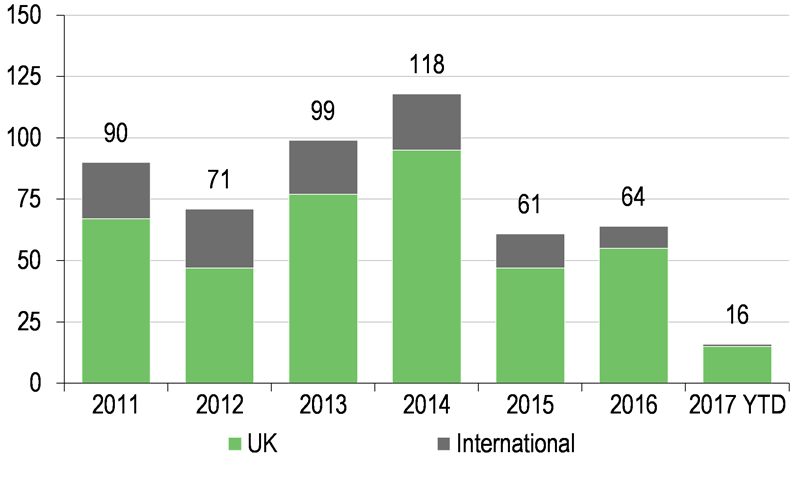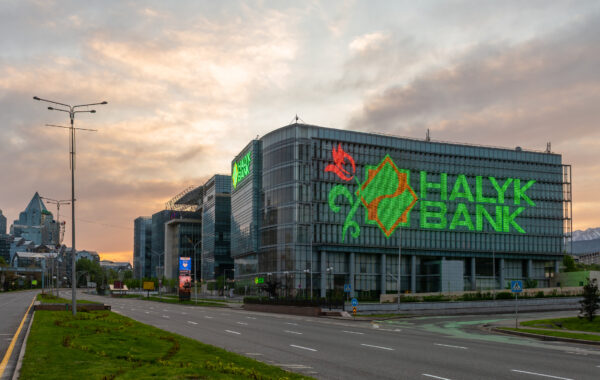Q117 results: Revenue, margin and profit improvement
OTC Markets’ first-quarter figures showed net revenues up nearly 5% and pre-tax profit more than 12% ahead compared with the same period last year. Revenue growth was most marked in the corporate services area where the main driver was the implementation of a price increase at OTCQX, while OTC Link ATS saw a moderate decline as the contraction in the number of broker-dealer subscribers continued. Market Data Licensing reported a modest increase in revenue with a strong increase in the number of non-professional users and demand for compliance data products being positive factors, while the number of professional users was only marginally down.
Importantly, while the corporate client count was down versus the end of March last year, the rate of new additions has improved over the last two quarters, suggesting OTCM’s focus on client acquisition is bearing fruit (see comments below).
Key data points from the first-quarter results (Q117 versus Q116 unless stated) included:
■
Among the operating metrics by business line, for OTC Link ATS the number of active broker-dealer subscribers (99) was down 15%. The trading system has maintained its 100% uptime record, which now extends over more than two years. Total clients (1,967) for corporate services were 2% lower and down 7% for OTCQX to 363. OTCQX has tightened its eligibility criteria and as at 1/1/17 26 companies did not meet the requirements but, this aside, the retention rate for calendar 2017 has improved. Also positively, the rate of new additions at OTCQX increased from 13 to 16 and from 56 to 82 for OTCQB.
■
The overall revenue increase of 4.9% included a sharper 13.6% increase for corporate services. As noted, an important factor here was the increase in the annual fee for existing clients in OTCQX from $15,000 to $20,000.
■
Expenses increased by less than 2% with compensation and IT costs up by 5-6%, while consulting and marketing costs were down by 30% and 14% respectively, the latter partly reflecting a move towards digital marketing.
■
As a result, the operating margin increased from 31% to 33% and pre-tax profit was up by 12.2%. Changes in accounting for stock-based compensation resulted in a lower tax charge (an effective rate of 28% versus 39%) with the effect set to be concentrated in the first quarter each year in line with vesting schedules. This allowed diluted earnings per share to increase by 31% to $0.26.
■
A $0.14 quarterly dividend was declared, the eighth at this level.
Exhibit 2: Q117 results summary
($000s unless stated) |
Q116 |
Q316 |
Q416 |
Q117 |
% change vs Q116 |
% change vs Q416 |
OTC Link ATS |
2,754 |
2,530 |
2,631 |
2,618 |
(4.9) |
(0.5) |
Market data licensing |
5,325 |
5,274 |
5,218 |
5,450 |
2.3 |
4.4 |
Corporate services |
4,672 |
4,809 |
5,029 |
5,308 |
13.6 |
5.5 |
Gross revenues |
12,751 |
12,613 |
12,878 |
13,376 |
4.9 |
3.9 |
Re-distribution fees and rebates |
(593) |
(557) |
(583) |
(624) |
5.2 |
7.0 |
Net revenue |
12,158 |
12,056 |
12,295 |
12,752 |
4.9 |
3.7 |
Operating expenses |
(8,361) |
(7,658) |
(7,683) |
(8,514) |
1.8 |
10.8 |
Income from operations |
3,797 |
4,398 |
4,612 |
4,238 |
11.6 |
(8.1) |
Other income / net interest |
(8) |
11 |
2 |
14 |
N/A |
N/A |
Income before provision for income taxes |
3,789 |
4,409 |
4,614 |
4,252 |
12.2 |
(7.8) |
Taxes |
(1,474) |
(1,404) |
(1,921) |
(1,202) |
(18.5) |
(37.4) |
Net income |
2,315 |
3,005 |
2,693 |
3,050 |
31.7 |
13.3 |
Diluted EPS $ |
0.20 |
0.26 |
0.23 |
0.26 |
31.0 |
11.8 |
Operating margin |
31% |
36% |
38% |
33% |
|
|
Source: OTCM, Edison Investment Research
The following table provides a summary of key operating metrics, together with related revenue data. In addition to the points mentioned above, we note the increase in revenue per client within Corporate Services, reflecting the price increase at OTCQX and a degree of average revenue dilution per user in Market Data Licensing, reflecting the growth in non-professional users.
Exhibit 3: Operating and related revenue data
|
Q116 |
Q316 |
Q416 |
Q117 |
% chg
y-o-y |
% chg
q-o-q |
OTC Link ATS |
|
|
|
|
|
|
Number of securities quoted |
9,819 |
9,644 |
9,633 |
9,638 |
(1.8) |
0.1 |
Number of active participants |
116 |
108 |
106 |
99 |
(14.7) |
(6.6) |
Revenue per security quoted ($) |
280 |
262 |
273 |
272 |
(3.2) |
(0.5) |
Revenue per average active participant ($) |
23,741 |
23,000 |
24,589 |
25,541 |
7.6 |
3.9 |
Revenue bps of volume traded |
0.61 |
0.54 |
0.46 |
0.47 |
(23.5) |
1.8 |
Corporate Services |
|
|
|
|
|
|
Number of corporate clients |
|
|
|
|
|
|
OTCQX |
388 |
387 |
398 |
363 |
(6.4) |
(8.8) |
OTCQB |
929 |
869 |
872 |
928 |
(0.1) |
6.4 |
Pink |
686 |
693 |
665 |
676 |
(1.5) |
1.7 |
Total |
2,003 |
1,949 |
1,935 |
1,967 |
(1.8) |
1.7 |
Revenue per client ($) |
2,333 |
2,467 |
2,599 |
2,699 |
15.7 |
3.8 |
Market Data Licensing |
|
|
|
|
|
|
Market data professional users |
20,923 |
22,096 |
20,628 |
20,700 |
(1.1) |
0.3 |
Market data non-professional users |
11,418 |
11,472 |
12,839 |
16,022 |
40.3 |
24.8 |
Revenue per user (total) |
165 |
157 |
156 |
148 |
(9.9) |
(4.8) |
Source: OTCM, Edison Investment Research
Other business and regulatory developments
OTCM is continuing to work with the North American Securities Administrators Association and individual state regulators to increase the number of states that accept the disclosure provided by OTCQX and OTCQB for the purpose of Blue Sky recognitions, which generally allow investment professionals to recommend qualifying securities to investors or purchase them for managed portfolios. In Q117 one further state (Delaware) was added to the list that recognises OTCQX, taking the total to 21 while 18 recognise OTCQB. The pace of additions appears to have slowed (between its H116 announcement and the FY16 announcement 15 states were added to the list), but OTCM notes that a number of states have announced a proposed rule change and this tends to take longer than if the change were through no-action letters and administrative actions.
The enhancement of OTCQX rules implemented in January this year should not only increase investor appreciation of the tiering between the markets, but may also help in the process of securing Blue Sky recognitions. Further recognitions in turn seem likely to enhance the reputation of OTCM’s two premium markets and increase their appeal to corporates as a venue for trading.
Exhibit 4: Blue Sky recognition for OTCQX and OTCQB
State |
Recognition |
State |
Recognition |
Alaska |
Both |
New Mexico |
Both |
Arkansas |
Both |
Ohio |
Both |
Colorado |
Both |
Oregon |
Both |
Delaware |
Both |
Rhode Island |
Both |
Georgia |
Both |
South Dakota |
Both |
Idaho |
OTCQX only |
Texas |
Both |
Iowa |
Both |
Vermont |
OTCQX only |
Kansas |
OTCQX only |
Washington |
Both |
Mississippi |
Both |
Wisconsin |
Both |
Nebraska |
Both |
Wyoming |
Both |
New Jersey |
Both |
|
|
A further rule change for OTCQX implemented in January was the removal of the requirement for an annual certification from an OTCQX professional adviser and that corporates’ information should be published in a recognised securities manual, lightening the administrative burden. For OTCQB a proposed amendment to standards will allow companies to qualify by following OTCM’s Alternative Reporting Standard (for US companies not reporting to the SEC) and similar corporate governance standards to OTCQX companies.
The Transfer Agent Verified Shares Program is another initiative to improve transparency by giving timely information on share issuance/share count, which helps investors to monitor potential dilution of their interests. Following its launch last year, during which seven agents signed up, the number of agents participating has increased to 10.
A potentially significant change in the competitive landscape is the move by Global OTC, a subsidiary of NYSE, to remove its quotes from OTC Link ATS, and to start operating a more directly competing alternative trading system employing a fully automated trading platform with a lit limit order book and auctions. Global OTC also provides real-time trade and quote data to investors, broker-dealers and market data distributors. Global OTC trades approximately 4,000 OTC securities and plans to trade all 10,000 securities by the end of 2017. The current fee structure is an execution charge of $0.003 per share (share price above $1.00) for liquidity removal with no rebate for adding liquidity. From the beginning of June incentives for monthly executed liquidity provided will apply, giving lower execution charges of $0.002 (1m to 50m shares) and $0.001 (over 50m shares) per share for liquidity removed. Data feeds are provided free of charge currently but charges will apply from the beginning of July. Global OTC implemented its plan at the beginning of May and early data indicate an average market share of c 9%. Based on these data, we estimate that OTC Link ATS has a market share of approximately 50% and understand that the remaining activity is accounted for by trades negotiated directly between broker dealers. Global OTC remains a trade messaging subscriber to OTC Link ATS as most of the trading carried out on the platform is with OTC Link ATS liquidity providers.
In response to this development OTCM has enhanced its system to allow OTC Link ATS subscribers to see aggregated market data and to route orders to Global OTC, limiting any disruption for its clients that might otherwise arise. OTCM notes that the loss of Global OTC as a subscriber will have a minimal impact on revenue but that it is too early to determine the competitive impact of its order book-based offering. We would observe that volume on the Global OTC platform may generate activity on OTC Link ATS as broker-dealers offset trades while related messaging revenues are likely to continue to flow to OTCM given the position of OTC Link ATS subscribers in this market. The longer-term impact on OTCM revenues for both OTC Link ATS and data licensing will hinge on whether Global OTC or any other inter-dealer quotation system is able to take a substantially higher market share. Also uncertain are the possible implications for the participation of smaller broker-dealers in the OTC market given the increase in costs arising from market fragmentation.
The presence of a credible competitor with a live trading system may reduce the chances of FINRA pursuing its proposal for an over-the-counter display facility (ODF, August 2016). This would act as a back-up to OTC Link ATS and appears to reflect concerns at the SEC regarding the availability of alternative channels in the event of a system failure. The proposal has been through an initial consultation period that only elicited three responses, each arguing against the adoption of the rule, and FINRA has not made any further announcement or submitted the proposal to the SEC.
























